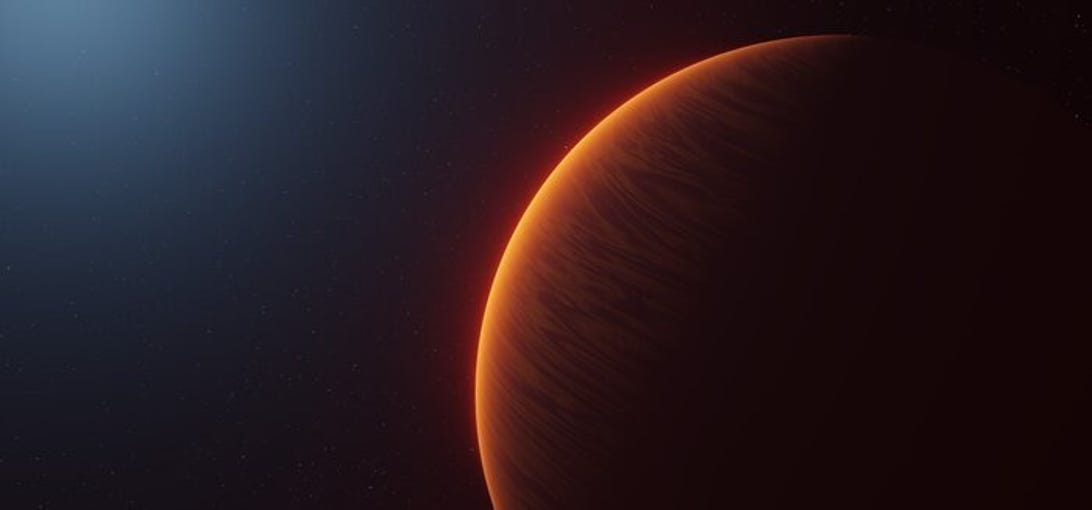[ad_1]

Artist’s influence of WASP-189b, an exoplanet orbiting the famous person HD 133112, which is considered one of the most up to date stars identified to have a planetary device.
Bibiana Prinoth
Roughly 322 light-years from Earth, an excessive planet by means of the title of WASP-189b orbits considered one of the most up to date stars within the universe, HD 133112.
Twenty occasions nearer to its famous person than we’re to the solar, WASP-189b completely blisters with a sunlight hours temperature of five,792 levels Fahrenheit (3,200 levels Celsius). The sizzling exoplanet could also be manufactured from fuel and about 1.5 occasions the dimensions of Jupiter — one thing like 1,950 Earths may just have compatibility within it.
Keep in mind that, since its discovery in 2018, scientists very understandably reasoned that WASP-189b is not the rest like our house orb. However in a paper printed Thursday within the magazine Nature Astronomy, a crew of researchers discovered some way for Earth to narrate to its far away cosmic relative. The 2 may just chitchat about their layered atmospheres, and Earth may just gossip about its ozone holes and local weather alternate.
Right here on Earth, we’ve got an atmospheric layer known as the troposphere that begins at sea stage and that holds a ton of water vapor. Clouds, and due to this fact climate similar to rain and snow, originate there. Above that, we’ve got the stratosphere, house to the ozone layer, which protects us from the solar’s ultraviolet radiation.
“Prior to now, astronomers incessantly assumed that the atmospheres of exoplanets exist as a uniform layer and take a look at to are aware of it as such,” Jens Hoeijmakers, an astrophysicist at Lund College and find out about co-author, mentioned in a commentary.
On the other hand, upon inspecting WASP-189b by means of measuring starlight passing during the surroundings of the intensely heated exoplanet — with the HARPS spectrograph on the L. a. Silla Observatory in Chile — Hoeijmakers and fellow researchers discovered a novel chemical signature to shake up our wisdom of planetary atmospheres. It indicated that the far away orb’s surroundings will have layers like Earth’s.
“The gases in its surroundings soak up one of the most starlight, very similar to ozone soaking up one of the most daylight in Earth’s surroundings, and thereby depart their function ‘fingerprint,'” Bibiana Prinoth, an astrophysicist at Lund College and lead writer of the find out about, mentioned in a commentary.
Baking away, WASP-189b emitted indicators of iron, chromium, vanadium, magnesium and manganese. However most significantly, Prinoth says, “in our research, we noticed that the ‘fingerprints’ of the other gases have been relatively altered in comparison to our expectation. We imagine that sturdy winds and different processes may just generate those alterations.”
The ones changes numerous around the vary of parts detected, in a similar way to the way in which Earth’s water vapor and ozone are affected in a different way by means of herbal processes because of atmospheric layering. Voila — that hints on the life of layers on WASP-189b, too.
However wait, there may be extra. The crew additionally exposed remnants of titanium oxide in WASP-189b’s atmospheric protect. “Titanium oxide absorbs shortwave radiation, similar to ultraviolet radiation,” Kevin Heng, an astrophysicist on the College of Bern and find out about co-author, mentioned in a commentary. “Its detection may just due to this fact point out a layer within the surroundings of WASP-189b that interacts with the stellar irradiation in a similar way to how the ozone layer does on Earth.”
So WASP-189b would possibly have its personal ozone layer.
“Our effects show that even the atmospheres of intensely irradiated massive fuel planets have complicated three-d constructions,” Hoeijmakers mentioned, addressing how the brand new paper’s results may just dictate the way in which exoplanet atmospheres are scrutinized at some point.
[ad_2]
Source_link
